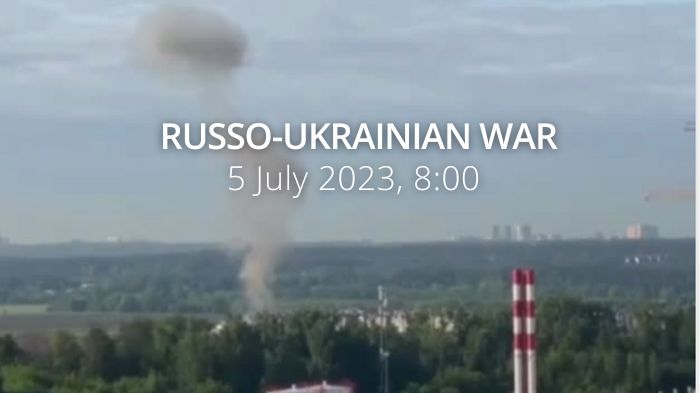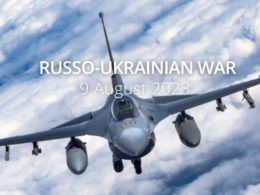Russia is likely focused on accusing Ukraine of irresponsible actions around the Zaporizhzhia nuclear power plant including setting conditions for a possible false flag attack. A drone attack near Moscow reported. Russian attack on Kharkiv Oblast injures 38, including 12 children
Daily overview — Summary report, July 5
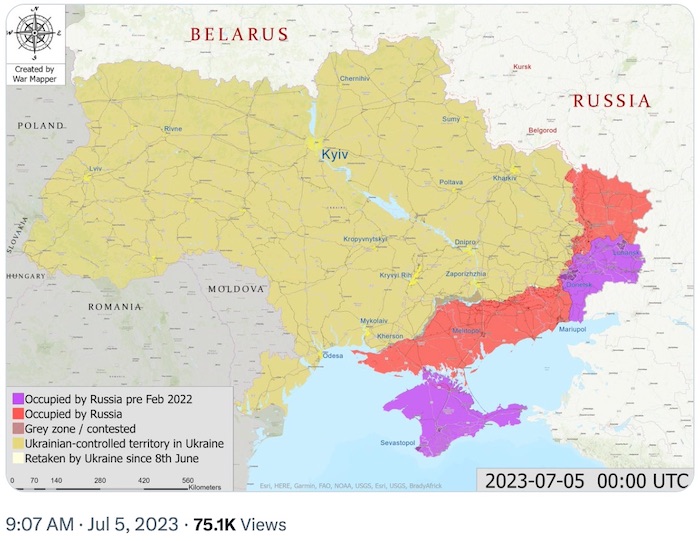
The General Staff’s operational update regarding the Russian invasion as of 18.00 pm, July 5, 2023 is in the dropdown menu below:
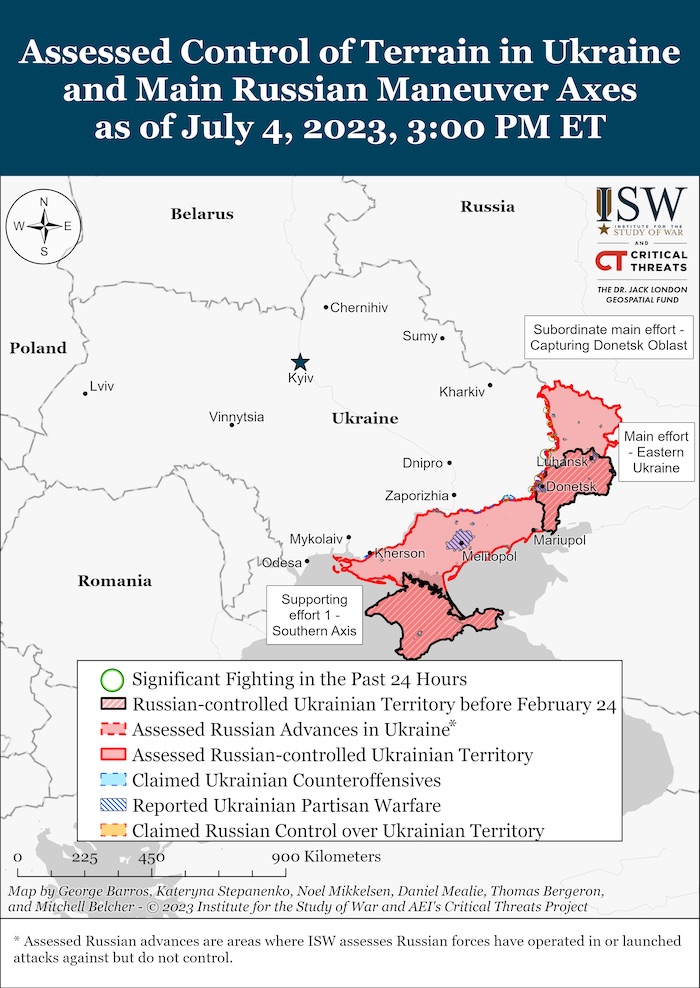
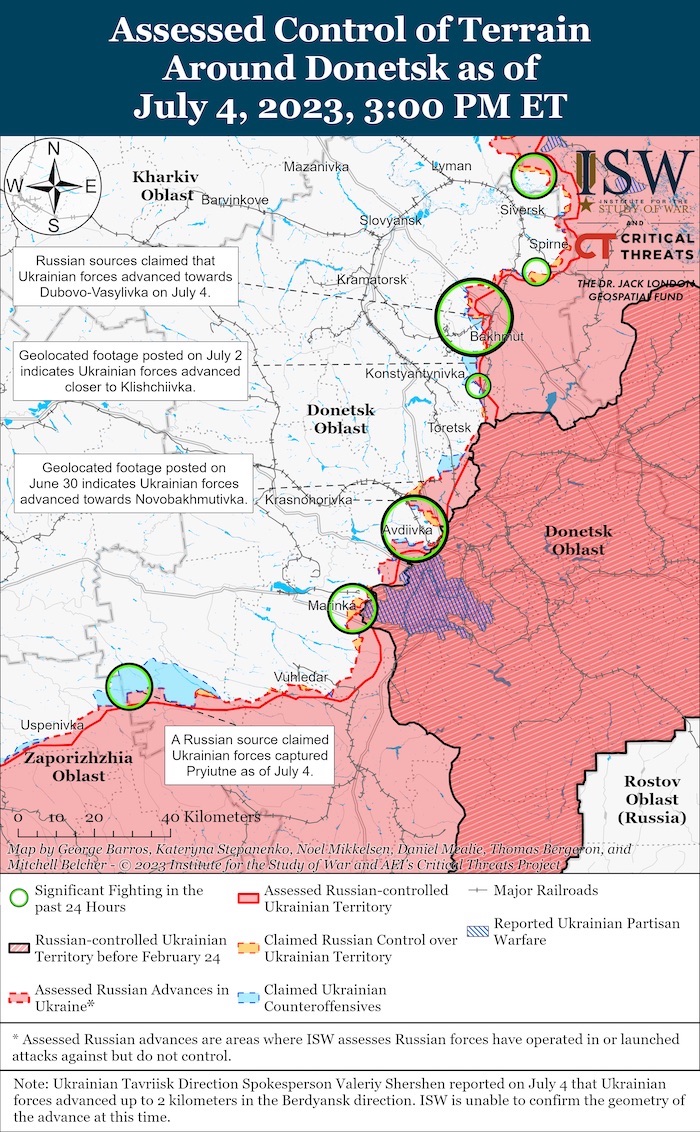
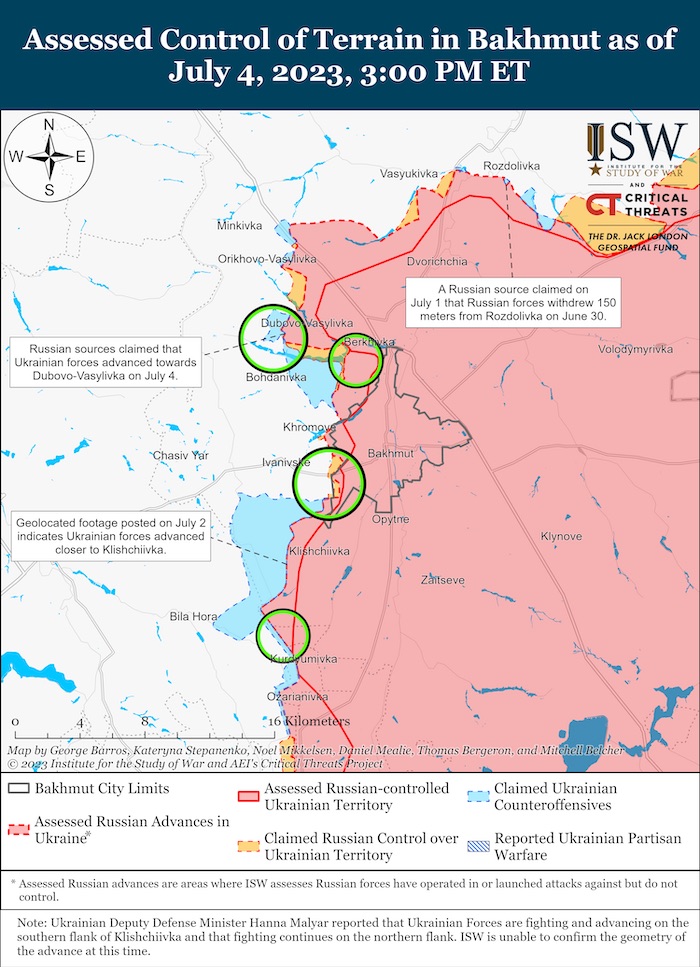
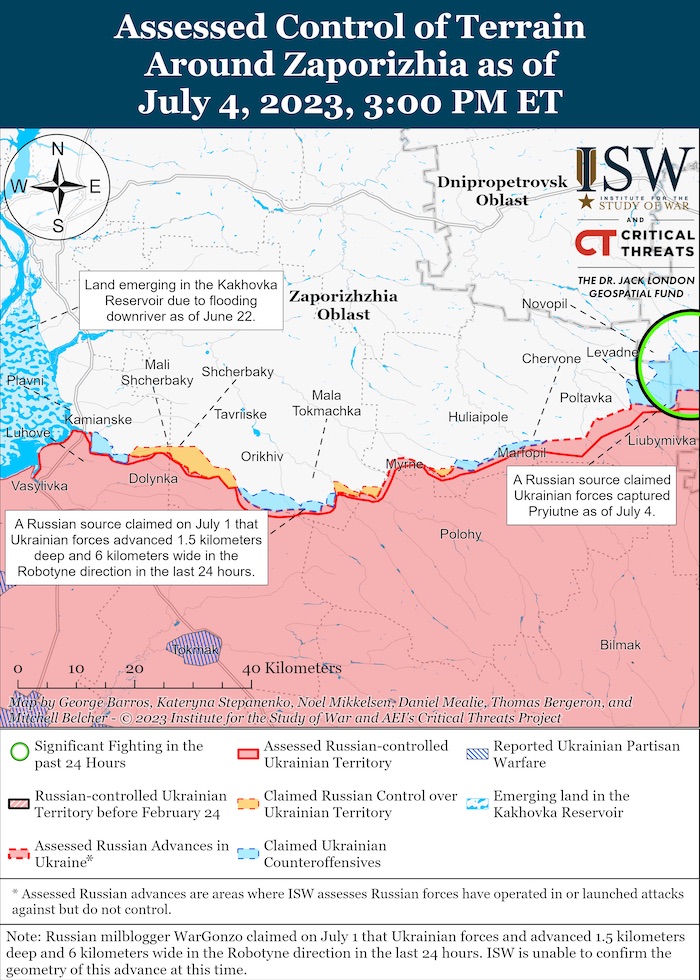
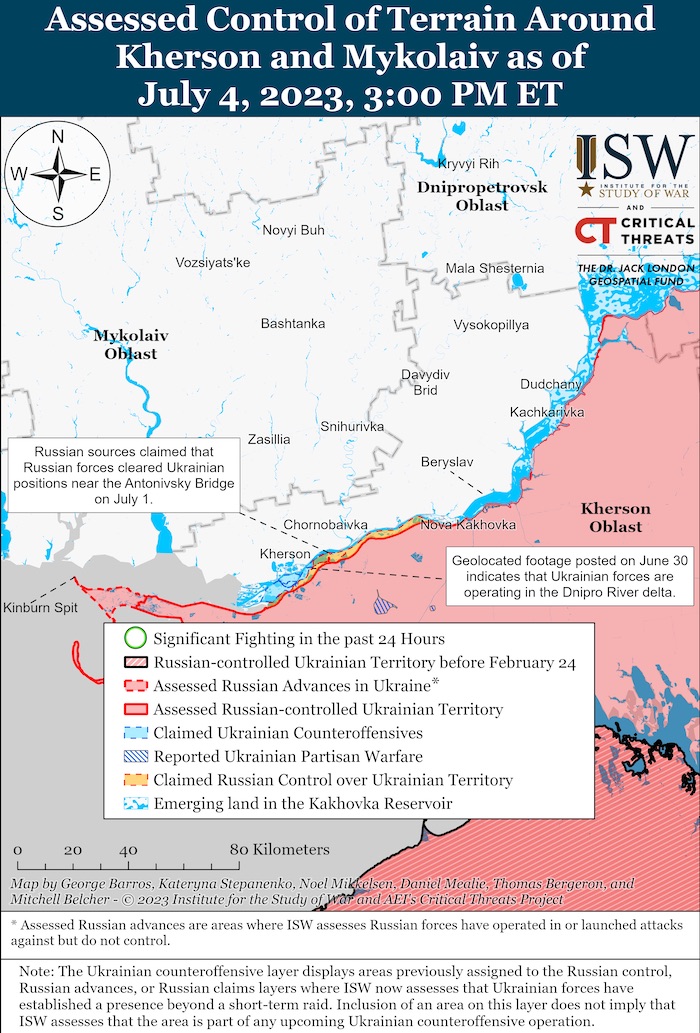
Military Updates
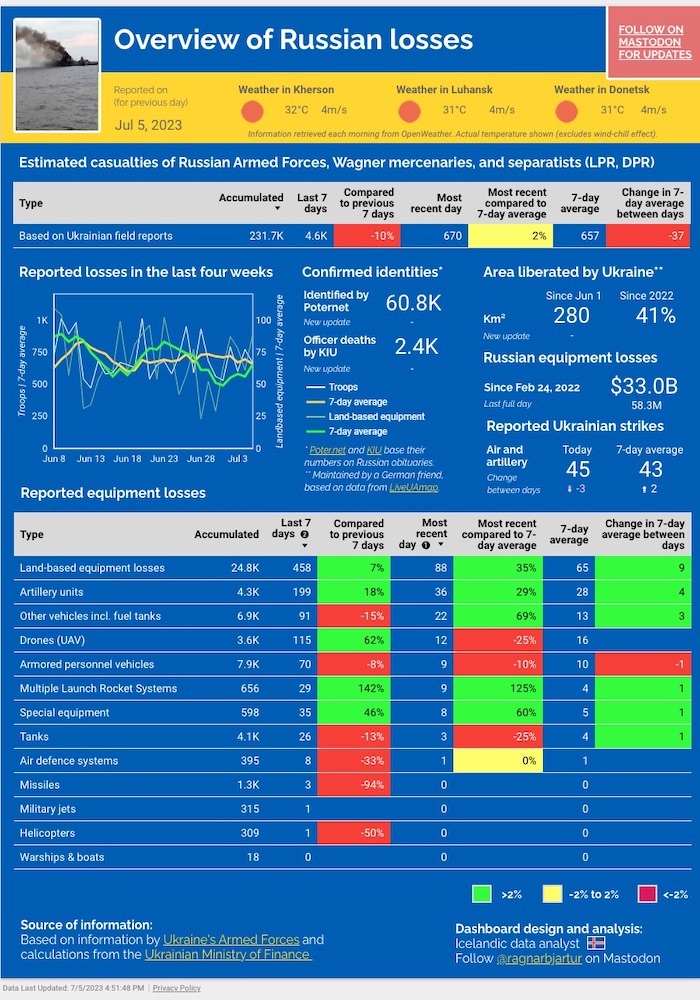
5 drones attacked Moscow; Russian Defense Ministry claimed that all were downed. The Russian Ministry of Defense said that Ukraine allegedly attacked the Moscow region with 5 drones, but all of them were shot down. Russian Ministry of Defense said that no propery was damaged as the consequence of the attack. Yevgeny Pisarenko, the commander of Akhmat, a Chechen military unit fighting on the Russian side since the beginning of the war, has been killed in Donbas, says another commander of the armed formation Apta Alaudinov.
According to British Defence Intelligence, (last 48 hours):
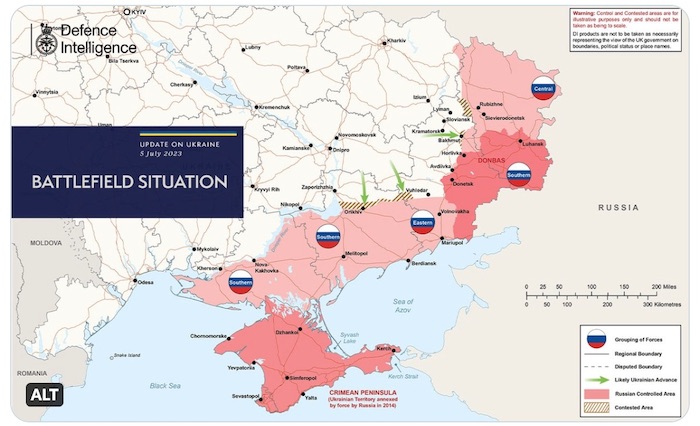
- General Sergei Surovikin, Commander-in-Chief Russian Aerospace Forces and deputy commander of Russian forces in Ukraine, has not been seen in public since the 23-24 June 2023 Wagner Group mutiny. Meanwhile, Deputy Defence Minister Colonel General Yunus-bek Yevkurov was notably absent from a televised appearance by the Ministry of Defence’s leadership on 03 July 2023.
- Similarly, Yevkurov was filmed talking to Wagner owner Yevgeny Prigozhin during the group’s uncontested take-over of Rostov-on-Don. Similarly, Yevkurov was filmed talking to Wagner owner Yevgeny Prigozhin during the group’s uncontested take-over of Rostov-on-Don.
- The suspicion that has potentially fallen on senior serving officers highlights how Prigozhin’s abortive insurrection has worsened existing fault lines within Russia’s national security community.
Reports of Surovikin’s arrest cannot be confirmed, but authorities will likely be suspicious of his long association with Wagner dating back to his service in Syria from 2017. Although largely known in the West by his brutal reputation, Surovikin is one of the more respected senior officers within the Russian military; any official sanction against him is likely to be divisive.
Losses of the Russian army
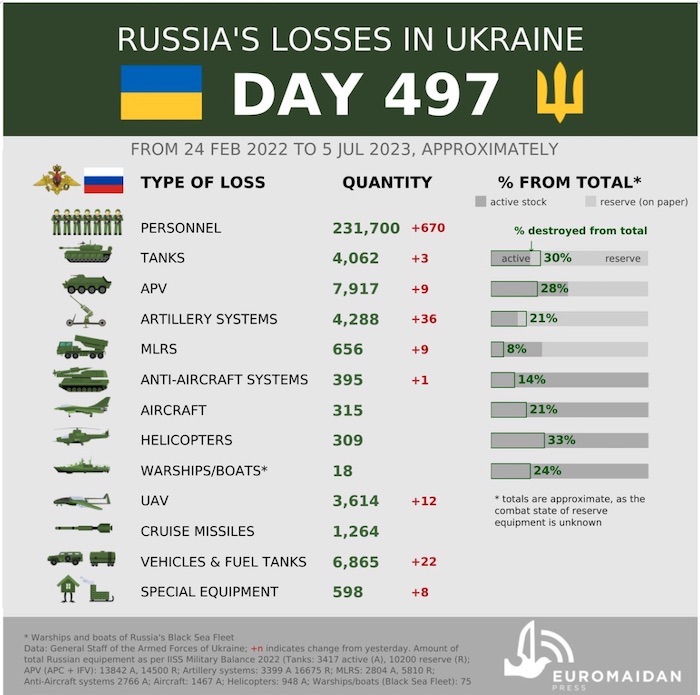
Humanitarian
Kyiv's population is now 3.6M, nearly recovering to Feb 2022 level of 3.9M
Half (1.9M) left during full-scale war, w/ 1.1M returning in last 1.5 y
500K-700K haven't returned yet, while 450K internally displaced ppl from other oblasts now reside in Kyiv https://t.co/rIokZVU3ZW pic.twitter.com/eWij3Z5Ipl
— Euromaidan Press (@EuromaidanPress) July 5, 2023
Deported Ukrainian mother and child overcome Russian border blockades to return home. A Ukrainian mother and her young son, previously deported to Russia, have successfully returned to Ukraine, despite repeated rejections by the Russian border authorities. This was reported by Ombudsman Dmytro Lubinets. The family reached out to the Ombudsman’s office in May this year after being unlawfully deported to Russia, seeking assistance to return to Ukraine.
Ukrainian mother & her little son, previously forcibly deported to Russia, have returned to Ukraine, despite repeated rejections by Russian border authorities. She reached to Ombudsman for help
As of now,125 children deported to Russia returned home https://t.co/F3KqN0vPuR pic.twitter.com/gEhv6FHkCM
— Euromaidan Press (@EuromaidanPress) July 5, 2023
Russian attack on Kharkiv Oblast injures 38, including 12 children (updated). On 4 July, Russians shelled the residential area of the city of Pervomaiskyi, Kharkiv Oblast, injuring 38 people, including 12 children, two of them are 1-year-old and 10-month-old infants, Prosecutor’s office of Kharkiv Oblast reports. According to preliminary information, the strike was carried out by an Iskander missile.
Environmental
Ukraine begins constructing 150 km of water pipelines to restore water supply to the country's south following Russia's destruction of the Kakhovka dam.
The pipelines will restore water supply to over 1 million people. https://t.co/Z2khtwDIyg pic.twitter.com/Vt5xD3DG8o
— Euromaidan Press (@EuromaidanPress) July 4, 2023
Russians install explosive-like objects on the roof of Zaporizhzhia NPP to imitate Ukrainian strikes. The General Staff of Ukraine’s armed forces reported on possible preparation of Russians for a provocation at the Zaporizhzhia NPP. Reportedly, foreign objects resembling explosives were placed on the roof of units 3 and 4 of the nuclear power plant. According to the General Staff, their detonation should not damage power units, but could create a picture of shelling from Ukraine. Russian telegram channels and mass media misinform about this.
Russian Foreign Ministry states it sees no reason to further Black Sea Grain Initiative. According to the Russian Foreign Ministry, Russia considers it impossible to continue “grain deal,” signed in the summer of 2022 to unblock the export of Ukrainian grain. “Black Sea Grain Initiative, intended to help needy countries in Africa, Asia and Latin America, has turned into a purely commercial export of Ukrainian provisions to ‘satiated’ countries. On this background, the situation with the normalization of provision and fertilizer supplies from Russia continued to degrade,” says Russian MFA.
Possible Russian attack on the power plant in Ukraine will affect the whole world – NATO Military Committee. On 3 July, the head of NATO’s Military Committee, Rob Bauer mentioned that if Russia attacks Zaporizhzhia nuclear power station (ZNPP), its consequences will affect the whole world. It is according to the interview Rob Bauer gave for LBC.
Ukraine begins construction of 150-km pipeline to restore water supply following Russia’s destruction of the Kakhovka dam. Ukraine has begun constructing the main water pipeline for the regions affected by the explosion of the Kakhovka dam. The project involves the construction of water pipelines connecting other water reservoirs with the Ukrainian cities of Kryvyi Rih, Marhanets, Nikopol, Tomakivka, and others. The project is planned to restore water supply to more than 1 million people from Zaporizhzhia, Kherson, Mykolayiv, and Dnipropetrovsk oblasts.
Support
Netherlands commits €118 million in economic and humanitarian aid for Ukraine’s rebuilding efforts. The Netherlands announces a second comprehensive support package for Ukraine in 2023, allocating over €118 million for humanitarian needs and economic assistance. This includes €93 million for humanitarian aid, out of a government reserve of €2.5 billion for Ukrainian support this year.
Promised F-16 training for Ukrainians delayed due to “miscalculation” of one of partner countries, Ukraine’s Foreign Minister says. Ukraine’s Foreign Minister, Dmytro Kuleba, has expressed disappointment over the delay of the promised F-16 fighter jet training for Ukrainians. One of the countries made a commitment to begin the training in June but failed, Kuleba said on TV air on Monday.
New Developments
OSCE Parliamentary Assembly calls Russia state sponsor of terrorism. The Parliamentary Assembly of the Organization for Security and Cooperation in Europe adopted a final declaration called Russia a state sponsor of terrorism and the private military company Wagner Group, a terrorist organization, Yevheniia Kravchuk, member of the Ukrainian delegation in PACE, reports.
Zelenskyy called on Biden to invite Ukraine into NATO now even if membership comes after the war — CNN. Ukraine’s President Volodymyr Zelenskyy called on American President Joe Biden to invite Ukraine into NATO now – even if membership does not come until the war ends. He said about this in his interview with CNN, which was announced to be published on 5 July.
Assessment
- On the war.
The Institute for the Study of War has made the following assessment as of July 4, 2022:
Ukrainian forces appear to be focusing on creating an asymmetrical attrition gradient that conserves Ukrainian manpower at the cost of a slower rate of territorial gains, while gradually wearing down Russian manpower and equipment. Ukrainian National Security and Defense Council Secretary Oleksiy Danilov reported on July 4 that Ukrainian forces are performing their main task of destroying Russian manpower, equipment, fuel depots, artillery, and air defenses and that a “war of destruction is equal to a war of kilometers.”[1] Danilov’s assessment underlines the prioritization of Ukraine’s ongoing campaign to attrit Russian manpower and assets over attempting to conduct massive sweeping mechanized maneuvers to regain large swaths of territory rapidly. NATO Military Committee Chair Admiral Bob Bauer reported on July 3 that Ukrainian forces are correct to proceed cautiously and avoid high casualties in the counteroffensive and acknowledged that the counteroffensive is difficult due to landmines and other obstacles up to 30km deep into Russian-occupied territory.[2] Bauer stated that Ukrainian forces should not face criticism or pressure for moving slowly.
Ukrainian forces have liberated territory in multiple areas of the front since the start of the counteroffensive in early June. Ukrainian Deputy Defense Minister Hanna Maliar reported on July 3 that Ukrainian forces have liberated a total of 37.4 square kilometers in eastern and southern Ukraine in the past week.[3] Ukrainian forces are continuing to make steady, gradual advances.
The current pace of Ukrainian operations is not indicative of a stalemate or evidence that Ukraine cannot retake large areas. Ukrainian forces conducted slow and gradual interdiction campaigns against Russian concentration areas in east (left) bank Kherson Oblast and limited ground attacks on the west (right) bank between August and November of 2022, before finally forcing the Russian withdrawal from the right bank in mid-November.[4] The situation in southern Ukraine is different, of course, because there is no natural bottleneck of the sort created by Russian reliance on the two bridges over the Dnipro. The Ukrainian counter-offensive in Kherson nevertheless alternated phases of relatively rapid advance with long periods of preparation, combat focused on attritting Russian forces, and limited gains that ultimately made Russian positions on the west bank of the river untenable. By contrast, the Russian winter-spring offensive culminated in just over one month without making significant gains along the Luhansk-Kharkiv Oblast border.[5] The current Ukrainian counter-offensive is less dramatic and rapid than the one that liberated much of Kharkiv Oblast, more successful than the failed Russian winter offensive, and generally most like the slower but ultimately successful Kherson counteroffensive in its pace and initial progress.
Ukrainian forces continued counteroffensive operations on at least four sectors of the front and advanced on July 4. The Russian Ministry of Defense (MoD) claimed that Russian forces repelled Ukrainian ground attacks in the Lyman direction.[6] The Ukrainian General Staff reported that Ukrainian forces continue counteroffensive operations in the Bakhmut area, in the western Donetsk-Zaporizhzhia Oblast border area, and in western Zaporizhzhia Oblast.[7] Ukrainian military officials stated that Ukrainian forces have made some unspecified advances on Bakhmut’s northern and southern flanks, and a prominent Russian milblogger also claimed that Ukrainian forces advanced north of Bakhmut.[8] Ukrainian Tavrisk Group of Forces Spokesperson Valery Shershen stated that Ukrainian forces advanced up to two kilometers in the western Donetsk-Zaporizhzhia Oblast border area, and a Russian milblogger claimed that Ukrainian forces reached Pryyutne, 15 kilometers southwest of Velyka Novosilka in western Donetsk Oblast.[9] Geolocated footage confirms that Ukrainian forces made additional advances south of Orikhiv in western Zaporizhzhia Oblast.[10]
Russian and Ukrainian officials escalated their rhetoric surrounding the situation at the Zaporizhzhia Nuclear Power Plant (ZNPP) on July 4, but Russia is likely focused on accusing Ukraine of irresponsible actions around the ZNPP including setting conditions for a possible false flag attack. Russia remains unlikely to generate a radiological incident at the ZNPP at this time. The Ukrainian General Staff reported on July 4 that Ukrainian officials have begun preparations for a potential Russian provocation at the ZNPP “in the near future” and warned that Russian forces placed objects “resembling explosive devices” on the outer roofs of the ZNPP’s third and fourth reactors in order to blame damage to these areas on Ukrainian shelling.[11] Ukrainian President Volodymyr Zelensky echoed this statement in his nightly address on July 4, and other Ukrainian military sources warned of possible Russian provocations at the plant.[12] As ISW has previously reported, it is unlikely that limited Russian sabotage at the ZNPP that Russia could hope to blame on Ukraine would be able to generate a massive radiological incident, as the ZNPP’s reactors were constructed to withstand considerable damage.[13] Ukrainian military sources reiterated this assessment and noted that even if the purported explosive devices detonate, the damage would not harm the reactor but would rather create the false impression that Ukrainian forces had shelled the reactors.[14] Advisor to the head of Russian nuclear energy operator Rosenergoatom, Renat Karchaa, also claimed on July 4 that Ukraine is planning to strike the ZNPP overnight on July 4-5.[15] ISW has previously assessed that such provocative Russian statements, and even the possibility of a tangible provocation at the plant, are likely part of a Russian wider information operation meant to accuse Ukraine of irresponsibility at the ZNPP ahead of the upcoming NATO summit and dissuade Ukrainian forces from conducting counteroffensive operations against occupied Zaporizhzhia Oblast.[16]
The reported reorganization of Russian internal security organs suggests that the Kremlin has not yet concluded that it has effectively neutralized the threats of future armed rebellions following the Wagner Group’s June 23-24 rebellion. Russian outlet Vedomosti reported on July 3, citing internal law enforcement sources, that Russian law enforcement authorities are considering reassigning the “Grom” special units of the Russian Federal Drug Control Service (part of the Ministry of Internal Affairs) to Rosgvardia (Russian National Guard).[17] Vedomosti noted that this reported change follows Russian President Vladimir Putin’s meeting with heads of various Russian law enforcement agencies on June 26 in the wake of the Wagner armed rebellion.[18] Several Russian sources spoke out against the reported transfer of ”Grom” to Rosgvardia, citing overall poorer equipment, training, and leadership quality.[19] Vedomosti claimed that Alexander Khinstein, former advisor to Rosgvardia Head Viktor Zolotov, warned that the assignment of ”Grom” units to Rosgvardia would be a ”dangerous experiment.”[20] The alleged restructuring of Russia’s internal security forces suggests that the Kremlin is working to build an effective anti-rebellion force following Wagner’s armed rebellion. The fact that these purported changes are happening following the rebellion indicates that the Kremlin was correctly dissatisfied with the performance of security forces, which failed to stop or even contest Wagner’s march on Moscow, and suggests that the Kremlin has not ruled out the risk of future such rebellions.
Russian authorities are absolving Wagner Group financier Yevgeny Prigozhin of financial responsibility for damages caused by the Wagner Group rebellion and reportedly returned significant liquid assets to Prigozhin, possibly as part of the deal negotiated between Putin, Prigozhin, and Belarusian dictator Alexander Lukashenko. The Rostov-on-Don administration claimed that the total damages from Prigozhin’s rebellion amounted to 92.5 million rubles (roughly $1 million), and that the administration will not recover damages from Prigozhin or the Wagner Group.[21] St. Petersburg news outlet Fontanka claimed, citing internal sources, that Russian authorities returned over 10 billion rubles (roughly $111 million) in cash, five gold bars, and hundreds of thousands of US dollars in cash to Prigozhin on July 2 that authorities had seized from Prigozhin-affiliated facilities in St. Petersburg on June 24.[22] Fontanka claimed that authorities only reversed their decision to hold onto Prigozhin‘s liquid assets on July 2 but did not specify a reason for the reversal. The legal basis that Russian authorities would have had for seizing Prigozhin’s assets remains unclear in any case, as Russian authorities dropped criminal charges against Prigozhin for the rebellion.[23] A prominent Russian milblogger claimed that part of Prigozhin’s liquid assets were supposed to be compensation to the families of Russian pilots whom Wagner forces killed during the rebellion, but it is now uncertain whether Wagner will make those payments.[24] The milblogger assessed that Wagner will likely use at least part of the returned assets to support transferring Wagner Group personnel to Belarus.
The official Chechen response to an attack against a Russian opposition journalist in Chechnya may impact Chechen Republic Head Ramzan Kadyrov’s standing in the Russian ultranationalist information space. Russian opposition outlet Novaya Gazeta reported on July 4 that unspecified, masked actors in Grozny, Chechnya intercepted a car containing one of its journalists, Yelena Milashina, severely assaulted Milashina, destroyed her equipment and documents, and warned Milashina against writing “anything.”[25] Milashina traveled to Chechnya in order to cover the trial of Zarema Musayeva, the mother of an exiled Chechen opposition activist, and the attackers also assaulted Musayeva’s lawyer, Alexander Nemov, who was in the car with Milashina. Chechen courts sentenced Musayeva to five and a half years in prison on July 5 for alleged fraud and attacking Chechen authorities, but some Russian opposition voices claimed that Chechen authorities prosecuted Musayeva due to her son‘s activism.[26] Prominent Russian ultranationalist voices seized on Milashina’s attack despite its lack of relevance to the war in Ukraine likely out of concern for broader press censorship.[27] The voices condemned attacks against journalists – including Milashina – as unacceptable even though they disagree with Milashina.[28] The Russian Union of Journalists and the Russian Human Rights Council both issued statements of condemnation and opened investigations into the attack.[29]
Kadyrov’s prominence in the broader Russian information space will likely force Kadyrov to choose between preserving his regime and his support in the ultranationalist information space, however. Kadyrov’s response was a brief acknowledgment that the relevant Chechen authorities are investigating the ”incident” – a response inconsistent in tone and content with Kadyrov’s usual flamboyant, long-winded messaging.[30] Kadyrov previously condemned Milashina as a ”terrorist” and demanded her detention, which is largely consistent with his overall effort to retain his authoritarian rule in Chechnya.[31] If Kadyrov supports the investigation into Milashina’s attack, he risks undermining his domestic regime and crackdowns against Chechen opposition voices. But if Kadyrov refuses to support the investigation, then he risks undermining his standing within an information space that is hypersensitive to the prospect of increased censorship. Kadyrov already struggles to balance these dual aims in his force arrayment in Ukraine; Kadyrov portrays Akhmat forces as capable fighters against Ukraine but has simultaneously largely avoided committing them intensive and attritional combat, and some Russian milbloggers have complained that Chechen forces are distracted posing online while other Russian forces actually fight.[32] Chechen forces notably failed to engage Prigozhin’s rebels despite ostentatiously mobilizing and moving ostensibly to fight them, although Putin might have directed Kadyrov to avoid combat with Wagner forces.[33]
Russia is reportedly forming a new combined arms army as part of the Northern Fleet, likely in order to posture its preparedness against NATO. Russian news outlet Izvestia reported that Russian Ministry of Defense (MoD) sources claimed that the existing 14th Army Corps of the Northern Fleet will be reformed into the new combined arms army with motorized rifle brigades, divisions, and regiments subordinate to it.[34] Izvestia suggested that the 14th Army Corps‘ 200th and 80th Brigades will be reorganized into a division under the new combined arms army.[35] Russian army corps before the 2022 invasion of Ukraine existed only within fleets and largely performed the same functions as combined arms armies. The reported decision to form a new combined arms army is thus likely posturing ahead of the NATO summit on July 11-12 intended to show Russia’s military response to the accession of Finland and possibly Sweden to the alliance. The promotion of the 14th Army Corps to a combined arms army level will not by itself increase Russian combat capacity, and it is unclear where the Russian military leadership could find the personnel and equipment that would be needed for the new organization to generate a material difference.
The Russian Ministry of Defense (MoD) claimed that Ukrainian forces conducted a drone attack on Moscow Oblast and Novaya Moskva on July 4. The Russian MoD claimed that Russian air defenses shot down and electronic warfare suppressed five of five Ukrainian drones.[36] Russian milbloggers claimed that Russian air defenses destroyed two drones near Valuevo, electronic warfare suppressed one in the Odinstovo Raion, one drone fell near Krivosheino, and one flew toward a military unit in Kubinka – likely the Russian airbase there.[37] One Russian milblogger claimed that Ukrainian forces may have intended to strike Vnukovo Airport, and Moscow Mayor Sergei Sobyanin announced that Russian authorities temporarily redirected some flights from Vnukovo Airport in response to the drones.[38] Another milblogger claimed that Ukrainian forces may have conducted the drone attack in retaliation for an alleged Russian strike on a Ukrainian Security Services (SBU) building in Sumy Oblast.[39]
Key Takeaways:
- Ukrainian forces appear to be focusing on creating an asymmetrical attrition gradient that conserves Ukrainian manpower at the cost of a slower rate of territorial gains, while gradually wearing down Russian manpower and equipment. The current pace of Ukrainian operations is not indicative of a stalemate or evidence that Ukraine cannot retake large areas.
- Ukrainian forces continued counteroffensive operations on at least four sectors of the front and advanced on July 4.
- Russian and Ukrainian officials escalated their rhetoric surrounding the situation at the Zaporizhzhia Nuclear Power Plant (ZNPP) on July 5, but Russia is likely focused on accusing Ukraine of irresponsible actions around the ZNPP including setting conditions for a possible false flag attack. Russia remains unlikely to generate a radiological incident at the ZNPP at this time.
- The reported reorganization of Russian internal security organs suggests that the Kremlin has not yet concluded that it has effectively neutralized the threats of future armed rebellions following the Wagner Group’s June 23-24 rebellion.
- Russian authorities are absolving Wagner Group financier Yevgeny Prigozhin of financial responsibility for damages caused by the Wagner Group rebellion and reportedly returned significant liquid assets to Prigozhin, possibly as part of the deal negotiated between Putin, Prigozhin, and Belarusian dictator Alexander Lukashenko.
- The official Chechen response to an attack against a Russian opposition journalist in Chechnya may impact Chechen Republic Head Ramzan Kadyrov’s standing in the Russian ultranationalist information space.
- Kadyrov’s prominence in the broader Russian information space will likely force Kadyrov to choose between preserving his regime and his support in the ultranationalist information space, however.
- Russia is reportedly forming a new combined arms army as part of the Northern Fleet, likely in order to posture its preparedness against NATO.
- The Russian Ministry of Defense (MoD) claimed that Ukrainian forces conducted a drone attack on Moscow Oblast and Novaya Moskva on July 4.
- Russian conducted limited ground attacks along the Kupiansk-Svatove-Kreminna line and south of Kreminna.
- Russian sources claimed that Ukrainian forces conducted limited ground attacks along the Kupiansk-Svatove-Kreminna line.
- Russian and Ukrainian forces escalated ground attacks in the Bakhmut area.
- Russian forces continued ground attacks along the Avdiivka-Donetsk City line on July 4.
- Russian and Ukrainian forces conducted ground attacks in western Donetsk Oblast.
- Russian sources claimed that Ukrainian forces continued counteroffensive operations near Orikhiv in western Zaporizhzhia Oblast.
- Russia continues efforts to mobilize its defense industrial base (DIB).
- Russian officials continue to deport Ukrainian children to Russia under the guise of providing pediatric healthcare.




